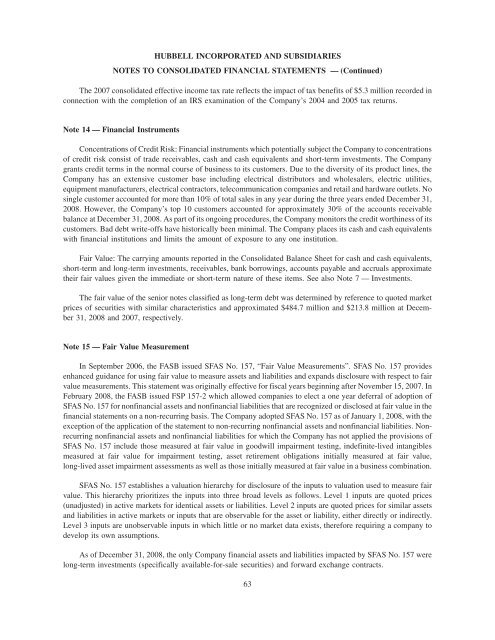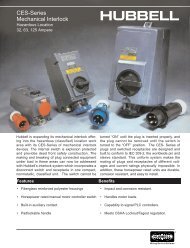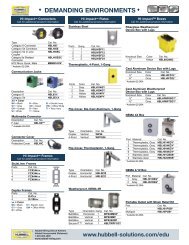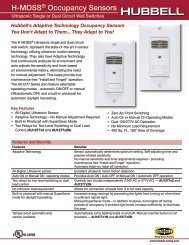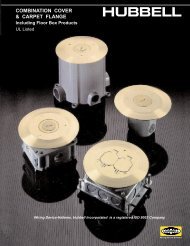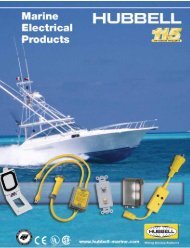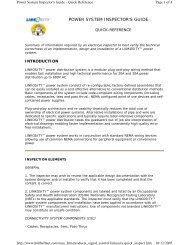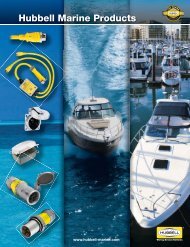2008 Annual Report - Hubbell Wiring Device-Kellems
2008 Annual Report - Hubbell Wiring Device-Kellems
2008 Annual Report - Hubbell Wiring Device-Kellems
- No tags were found...
Create successful ePaper yourself
Turn your PDF publications into a flip-book with our unique Google optimized e-Paper software.
HUBBELL INCORPORATED AND SUBSIDIARIESNOTES TO CONSOLIDATED FINANCIAL STATEMENTS — (Continued)The 2007 consolidated effective income tax rate reflects the impact of tax benefits of $5.3 million recorded inconnection with the completion of an IRS examination of the Company’s 2004 and 2005 tax returns.Note 14 — Financial InstrumentsConcentrations of Credit Risk: Financial instruments which potentially subject the Company to concentrationsof credit risk consist of trade receivables, cash and cash equivalents and short-term investments. The Companygrants credit terms in the normal course of business to its customers. Due to the diversity of its product lines, theCompany has an extensive customer base including electrical distributors and wholesalers, electric utilities,equipment manufacturers, electrical contractors, telecommunication companies and retail and hardware outlets. Nosingle customer accounted for more than 10% of total sales in any year during the three years ended December 31,<strong>2008</strong>. However, the Company’s top 10 customers accounted for approximately 30% of the accounts receivablebalance at December 31, <strong>2008</strong>. As part of its ongoing procedures, the Company monitors the credit worthiness of itscustomers. Bad debt write-offs have historically been minimal. The Company places its cash and cash equivalentswith financial institutions and limits the amount of exposure to any one institution.Fair Value: The carrying amounts reported in the Consolidated Balance Sheet for cash and cash equivalents,short-term and long-term investments, receivables, bank borrowings, accounts payable and accruals approximatetheir fair values given the immediate or short-term nature of these items. See also Note 7 — Investments.The fair value of the senior notes classified as long-term debt was determined by reference to quoted marketprices of securities with similar characteristics and approximated $484.7 million and $213.8 million at December31, <strong>2008</strong> and 2007, respectively.Note 15 — Fair Value MeasurementIn September 2006, the FASB issued SFAS No. 157, “Fair Value Measurements”. SFAS No. 157 providesenhanced guidance for using fair value to measure assets and liabilities and expands disclosure with respect to fairvalue measurements. This statement was originally effective for fiscal years beginning after November 15, 2007. InFebruary <strong>2008</strong>, the FASB issued FSP 157-2 which allowed companies to elect a one year deferral of adoption ofSFAS No. 157 for nonfinancial assets and nonfinancial liabilities that are recognized or disclosed at fair value in thefinancial statements on a non-recurring basis. The Company adopted SFAS No. 157 as of January 1, <strong>2008</strong>, with theexception of the application of the statement to non-recurring nonfinancial assets and nonfinancial liabilities. Nonrecurringnonfinancial assets and nonfinancial liabilities for which the Company has not applied the provisions ofSFAS No. 157 include those measured at fair value in goodwill impairment testing, indefinite-lived intangiblesmeasured at fair value for impairment testing, asset retirement obligations initially measured at fair value,long-lived asset impairment assessments as well as those initially measured at fair value in a business combination.SFAS No. 157 establishes a valuation hierarchy for disclosure of the inputs to valuation used to measure fairvalue. This hierarchy prioritizes the inputs into three broad levels as follows. Level 1 inputs are quoted prices(unadjusted) in active markets for identical assets or liabilities. Level 2 inputs are quoted prices for similar assetsand liabilities in active markets or inputs that are observable for the asset or liability, either directly or indirectly.Level 3 inputs are unobservable inputs in which little or no market data exists, therefore requiring a company todevelop its own assumptions.As of December 31, <strong>2008</strong>, the only Company financial assets and liabilities impacted by SFAS No. 157 werelong-term investments (specifically available-for-sale securities) and forward exchange contracts.63


